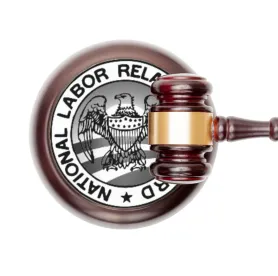Does an employer who genuinely believes that its workers are independent contractors and tells them that they are contractors and not employees, only to later find out that it was wrong, violate Section 8(a)(1) of the National Labor Relations Act (NLRA or Act)? Unions and workers’ advocates argue that such erroneous classifications/announcements should be illegal because when an employer misclassifies statutorily covered employees, they effectively convey the message to the employees that they have no rights under the law when, in fact, they do. Recognizing the importance of this issue, on February 15, 2018, the National Labor Relations Board (NLRB or Board) issued a Notice and Invitation to parties in a pending matter, Velox Express, Inc., Case No 15-CA-184006 and interested amici to file briefs to address the following question:
Under what circumstances, if any, should the Board deem an employer’s act of misclassifying statutory employees as independent contractors a violation of Section 8(a)(1) of the Act?
On August 29, 2019, the Board issued its decision in that matter, Velox Express, Inc., 368 NLRB No. 61, and ruled that such honest, albeit mistaken, classification decisions and their announcements to employees do NOTviolate the Act. The facts and the reasoning leading to this unprecedented decision are as follows:
In mid-2016, Velox, a medical courier service utilizing drivers called “medical couriers” who drove their personal vehicles to pick up and consolidate medical samples and to deliver them to its customer’s diagnostic laboratory, entered into purported independent contractor agreements with each of its drivers. However, thereafter and notwithstanding the terms of the independent contractor agreement, Velox treated the drivers in a manner characteristic of an employer-employee relationship. Later, Velox terminated one of its drivers who, in turn, filed an unfair labor practice (ULP) charge with the NLRB contesting the lawfulness of her discharge and alleging that her former employer also violated the Act by misclassifying her and her coworkers as independent contractors. After being investigated, the charge went to complaint and the administrative law judge (ALJ) hearing the case issued a decision (ALJD, which decision is appended to the Board’s decision linked above), concluding 1.) that Velox’s drivers were statutory employees covered by the Act and not exempt independent contractors, 2.) that the charging party had been wrongfully fired in violation of Section 8(a)(1) and 3.) that Velox also violated Section 8(a)(1) by misclassifying its drivers as independent contractors.
On administrative review of the ALJD, the Board affirmed the ALJ’s first two findings, but rejected and reversed his finding that Velox’s misclassification of its drivers violated Section 8(a)(1). Contrary to the ALJ, the Board concluded that misclassification standing alone was not coercive and, therefore, did not violate the Act. Indeed, according to the Board, when an employer decided to classify workers as independent contractors, it had formed and was merely acting on a legal opinion and that its mere announcement of that opinion to its workers was non-coercive free speech and privileged under Section 8(c) of the Act because it did not invoke the Act, did not prohibit workers from engaging in NLRA-protected conduct and did not threaten workers with adverse consequences for doing so. Nor did the fact that the announcement had ultimately been proven to be erroneous change things render it coercive or unprivileged because, mistaken as it was, it still did not contain any threat or reprisal or force or promise of a benefit.
While sanctioning standalone misclassification announcements, the Board was also quick to distinguish Velox from prior Board decisions where an employer’s statements as to workers’ independent contractor status was expressly or implicitly linked to NLRA-protected activity or where classification decisions were in response to or used as a way of chilling statutorily protected conduct. For example, an employer who told its employees that they could not engage in protected concerted or union activities because they were independent contractors when, in fact, they were employees violated the Act. Likewise, an employer who reclassified its employees for the purpose of defeating their efforts to union organize would also violate the NLRA. In such instances, an employer’s invocation of independent contractor status did have a coercive effect, rendering its announcement an 8(a)(1) violation. However, absent such an actual linkage to protected activity, the Board concluded that, “it is a bridge too far for us to conclude that an employer coerces its workers in violation of Section 8(a)(1) whenever it informs them of its position that they are independent contractors if the Board ultimately determines that the employer is mistaken.”
Additionally, the Board found several compelling legal and policy concerns weighing against finding a standalone misclassification violation. Principal among them, it noted that were it to declare an employer’s mere misclassification a per se violation, it would be acting in contravention to the Act’s Taft-Hartley amendments which excluded independent contractors from the statutory definition of “employee”. The Board further concluded that such declarations would improperly chill the creation of otherwise lawful independent contractor relationships by subjecting them to potential ULP charges and with them the possibility of protracted litigation.
Velox is the third recent case development coming out of the Board to positively affect employers faced with independent contractor issues, joining SuperShuttle DFW, Inc., 367 NLRB No. 75 (January 25, 2019) (finding shuttle drivers to be independent contractors because they met the multifactored common law test for independent contractors and the overall effect of those factors demonstrated the drivers’ pursuit of entrepreneurial opportunity) and the NLRB General Counsel’s advice memo in Uber Technologies, Inc., 13-CA- 163062, 14-CA-158833, and 29-CA-177483, dated April 16, 2019)(finding Uber drivers to be independent contractors applying the test in Supershuttle).
TAKEAWAYS FROM VELOX:
-
Unlike many other agencies and courts facing the issue, the current Board does not disfavor independent contractor relationships or see the creation of such relationships as something to be avoided. To the contrary, it sees the relationship as a legitimate alternative to the employer-employee relationship to be recognized and given effect when supported by the facts.
-
Misclassifications and standalone announcements of independent contractor status do not, in and of themselves, violate the Act. Employers who genuinely believe their workers to be independent contractors may share that belief with their workers even if it is wrong without fear of being prosecuted by the Board’s General Counsel, provided their statements are not expressly or implicitly linked to the workers’ engaging in NLRB protected activities or made to chill such conduct.
-
Notwithstanding Velox, employer’s still may not use erroneous classifications as a basis for telling workers that they may not engage in union or other protected concerted activities (PCA) or threaten them with adverse consequences for engaging in such conduct. Nor may they reclassify employees to independent contractors as a response to unionization or the employee’s PCA.
-
Independent contractor determinations can be extremely fact intensive and nuanced, and Board law is unfortunately not the only consideration, as the legal tests used to determine independent contractor status by enforcement agencies and courts vary greatly from law to law and state to state. Under some state laws, workers may, indeed, qualify as exempt independent contractors, while under others, those same workers are statutorily covered employees. See our recent blog discussing this thorny issue (Which Are They? Independent Contractors or Employees? Navigating the Conflicts Between State and Federal Law). Of note for many employers is the California Supreme Court’s 2018 landmark decision in Dynamex v. Superior Court, 4 Cal. 5th 903 (2018). As previously reported, the Dynamex Court abandoned the state’s traditional reliance on a common law agency test and devised a new employee-independent contractor test based upon giving a state law its widest possible effect. In fact, Dynamex creates one of the most stringent standards in the United States for classifying workers as independent contractors, and has already caused unintended consequences for California healthcare employers. Employers are encouraged to assesses their retroactive and future risk of misclassification.





 />i
/>i

